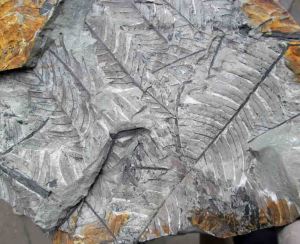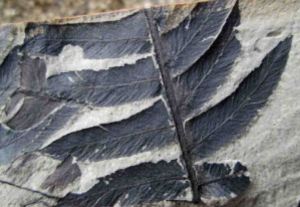The fern Cladophlebis is probably the single-most common plant fossil in the New Zealand Jurassic. It’s present in virtually every plant fossil site of that age, so much so that Mildenhall (1974) referred to it as ‘Mesozoic weed’. When New Zealanders talk about ‘fern rock’, it’s a good bet they’re referring to a deposit of fossil Cladophlebis. It’s abundance and ubiquity suggest we should be making the most of it – so just what is this Cladophlebis?

A typical slab of ‘fossil fern rock’ from the Catlins, New Zealand. The preserved length of the frond at right is about 100 mm.

Detail of a Cladophlebis patagonica. As usual, vein details are somewhat vague, but enough to show that they only fork once. Pinnule lengths about 15 mm.
Cladophlebis was first defined by Brongniart in 1849. He wrote (my translation from the French):
This genus, which corresponds to the section of Pecopteris neuropteroides, (?In) the history of fossil Vegetables, still seems to me, after a more extended study, a natural and rather easy group to be characterized and able to be raised to the rank of genus; it actually forms the transition of Pecopteris to Neuropteris, it differs from the later by the pinnules which are not isolated from the rachis, but that are close-fitting to it though often free between them, and even partly contracted, and display a short rounded ear at their base; which is seen especially in Pecopteris nestleriana and P. defrancii. The veins are less fine, more separated, and are less obliquely branch from the median vein which, although fades towards end, persists in a distinct way up to the apex. These plants differ from other genera formed at the expense of Pecopteris, and particularly from the true Pecopteris, by their bent/hooked secondary veins and dichotomies. Cladophlebis pteroides has so much affinity with the true Neuropteris, by its absolute characters, that perhaps we should place it in this genus, though it does not have ‘respect’ of it. Several species of this genus belong to the Mesozoic, but most of them come from coal fields.
Cladophlebis therefore, is used for fern fronds with pinnules that are attached to the rachis, and have a median vein that runs to the apex of the pinnule, and veins from that are curved and dichotomise. Other characters, such as the vein thickness, separation, and branching angle, are more subjective and relative to the genera Neuropteris and Pecopteris. It’s not much to go on, but the genus has persevered – and quite a number of species have been described for it.
Cladophlebis was gradually recognised as a ‘form genus’. That is, it was applied to a morphology where the higher relationships – i.e. the family, were not known. However, the family relationships for at least some Cladophlebis did become clear, or at least suspected. For example, some fronds have been found with the fertile sori (which are a good clue to a fern’s family) and sometimes they have been found with petrified stems. In several instances these have indicated the family was the Osmundaceae, although Dicksoniaceae and Schizaeaceae are also known to have had Cladophlebis foliage.
But, and here things get even more complicated, a Cladophlebis frond with attached sori can be identified to a family, so it can be placed into an ‘organ genus’. For most Cladophlebis-with-fronds, this is Todites (Harris 1937). The stems are treated separately and receive such names as ‘Osmundites‘. More recently, both ‘form genus’ and ‘organ genus’ have been dropped by the International Botanical Code – in favour of ‘morphogenus’ (see Bateman and Hilton 2009 for a detailed discussion of this topic). Whatever word is used to describe it, Cladophlebis remains a term to describe a fairly broad shape. Although one frequently comes across comments that Cladophlebis became extinct at the end of the Mesozoic, this is not true. The morphology covered by Cladophlebis exists today. It’s simply that by convention paleobotanists usually refrain from using ‘form genera’ in the Cenozoic and tend to place fronds in extant genera.
There aren’t too many characters that can be used to split Cladophlebis into species-sized bites. There is the size and shape of the pinnules, whether the margin is toothed or smooth, and the forking behaviour of the veins (i.e. forking once, twice, at the mid vein or distant from it, and so-on). Following the work of the paleobotanists who pioneered study of New Zealand’s fossil plants (Arber 1917 and Edwards 1934) there appeared to be at least five species of Cladophlebis in the New Zealand Jurassic. These were: Cladophlebis australis, C. sp. cf. C. albertsi, C. antarctica, C. denticulata and C. cf. reversa. Arber (1917, 31) regarded C. australis as the “most abundant of all species, without exception” in the New Zealand Jurassic.
However, a few years later, Frenguelli (1947) decided that the New Zealand Jurassic ‘Cladophlebis australis‘ actually belonged in a new species. He named this Cladophlebis patagonica, and it could be recognised by having lateral veins that mostly bifurcated only once, whereas in the real C. australis double-bifurcation was prominent. Herbst (1971) formalised the description of C. patagonica as part of a review of the Argentinian Cladophlebis. Retallack (1983), a specialist in the Triassic, noted that based on the double-forking definition, C. australis is a species basically restricted to the Triassic. In my work on the Jurassic of the Catlins coast, I’ve only seen rare instances of double-bifurcation (despite being common fossils, details of the venation can be frustratingly vague). These are probably just a morphological extreme in a population of Cladophlebis patagonica. However, in the North Island, Thorn (2001, fig. 6d) illustrates a Cladophlebis pinnule with several instances of double (as well as ? ‘one and a half’) bifurcation, compares with with C. australis.
Cladophlebis antarctica and C. denticulata seem to be good identifications in the New Zealand Jurassic. They both have non entire pinnule margins (variously described as toothed, crenate,serrate, serrulate) and can be distinguished on pinnule form, angle and vein spacing (Gee 1989). The remaining species are probably bad ideas – based on poor specimens that little can be done with. Thus the total Cladophlebis in the New Zealand Jurassic appears to have been just three, though careful analysis of pinnule size and shape may well tease out some more. This total compares with the six that Herbst (1971) concluded with for the Patagonian Early Jurassic, but which decreased also to three in the Middle and Late Jurassic.
Based on our Cladophlebis species New Zealand in the Jurassic had links with Patagonia. Two of the species, C. antarctica and C. denticulata, are also present in the Cretaceous of Hope Bay, Antarctica (Gee 1989). It’s highly likely that New Zealand shared Cladophlebis species with eastern Australia, although at the moment this remains somewhat unclear. Just like New Zealand, earlier workers in Australia tended to lump their Jurassic Cladophlebis into C. australis. More recent workers have been more cagey – McLoughlin et al. (1995) declined to put their Early Cretaceous Cladophlebis into any species. They noted that variation over individual fronds was so much that they could be compared with several species. They did note their material was similar to what has been described as Cladophlebis australis – but also noted that the veins in their material could dichotomise once or twice. It may yet be that Cladophlebis patagonica is applicable to some Australian fossils.
In the Catlins of New Zealand, petrified stems are commonly found closely associated with Cladophlebis fronds. Most of these were probably the stems of C. patagonica and indicate it was a modest-sized tree-fern. There are more than two species of fossil stem – in agreement with more than one species of Cladophlebis. However, the stems are another part of a complicated story. ‘Mesozoic weed’ would avoid a lot of head-scratching….
References
Bateman, R. M. & Hilton, J. 2009: Palaeobotanical systematics for the phylogenetic age: applying organspecies, form-species and phylogenetic species concepts in a framework of reconstructed fossil and extant whole-plants. Taxon 58: 1254-1280.
Brongniart, A.T. 1849. p. 74, In d’Orbigny, A. C. V. D. ‘Dictionairre Universel d’Histoire Naturelle’ Vol 13. Langlois et Leclerq, Paris.
Edwards, W.N., 1934: Jurassic plants from New Zealand. Annals and Magazine of Natural History 10, 81-109.
Frenguelli, J., 1947: El género Cladophlebis y sus representantes en la Argentina. Anales del Museo de La Plata (Nueva Serie) 2, 1-74.
Harris, T. M. 1937: The fossil flora of Scoresby Sound, East Greenland, part 5. Meddeleeser om Gronland 112(2): 1-114.
Herbst, R. 1971: Palaeophytologia Kurtziana III. 7. Revision de las especies Argentinas del genero Cladophlebis. Ameghiniana 8: 265-281.
Mildenhall, D. C. 1974: The record of the rocks. New Zealand’s Nature Heritage 1: 43-47.
Thorn, V. 2001: Vegetation communities of a high paleolatitude Middle Jurassic forest in New Zealand. Palaeogeography, Palaeoclimatology, Palaeoecology 168: 273-289.

3 comments
Hi Mike,
I wonder what Cladophlebis seeds look like? I have found a number of seed pods from about 120mya in Inverloch, Australia, along with some Cladophlebis fossils and would like to identify what genera they came from. The pods look woody and are about 5mm in diameter (round or oval shaped). Just wonder if you have any thoughts on this?
Kind regards,
Dr Sheahan Bestel
Hi Sheahan, sounds interesting! Cladophlebis will just have spores – sometimes you might see the fronds with the shapes of sporangia on them. So whatever you have will be something else. Maybe send a photo? I’ll email directly. Cheers, Mike
Have you ever considered about including a little bit more than just your articles? I mean, what you say is important and all. Nevertheless think about if you added some great graphics or videos to give your posts more, “pop”! Your content is excellent but with pics and clips, this website could definitely be one of the greatest in its niche. Good blog!